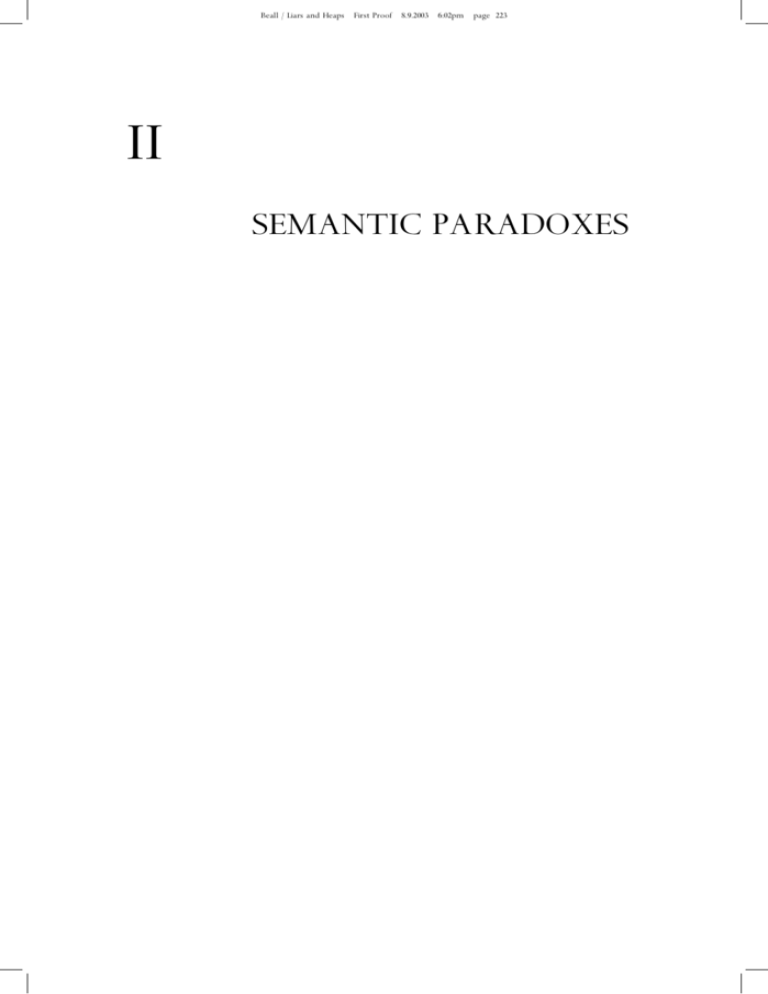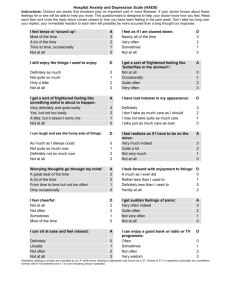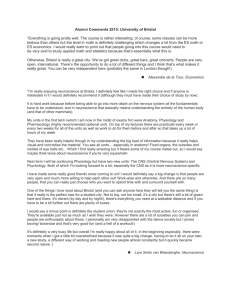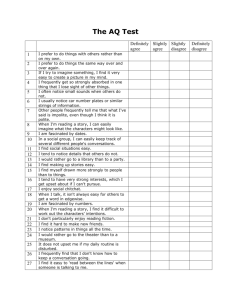SEMANTIC PARADOXES
advertisement

Beall / Liars and Heaps First Proof 8.9.2003 6:02pm page 223 II SEMANTIC PARADOXES Beall / Liars and Heaps First Proof 8.9.2003 6:02pm page 224 Beall / Liars and Heaps First Proof 8.9.2003 6:02pm page 225 10 A Definite No-No Roy A. Sorensen From the summit of Delia Graff ’s ‘Infinitely Higher-Order Vagueness’ (Graff 2002), I spied a curiosity nestled in the valley below. I was primed by Professor Graff ’s high-altitude discussion of relationship between definite operators and rules of inference. The puzzle I will discuss below echoes her interests; it raises, in miniature, an issue about the relationship between definiteness and proof. Since those presiding over this conference gave commentators wide latitude in their responses, I will not resist the temptation to lower the level of discussion. 1. Indefinite Denial In Greek mythology Acrisius and Proetus are twins who quarrel in the womb. Since Acrisius and Proetus were not fully formed beings, their dispute is of an indefinite nature. I name the following pair of denials in their honor: acrisius. Proetus is not definitely true. proetus. Acrisius is not definitely true. I have given each sentence ‘‘equal billing’’ to ensure that they are asserted in parallel. Neither is the ‘‘first’’ sentence. Consequently, there is no difference in their context or level of truth or level of determinacy. There is no principled way of assigning a different subscript to Acrisius’ use of ‘true’ than Proetus’ use of ‘true’. Beall / Liars and Heaps First Proof 8.9.2003 6:02pm page 226 226 / Roy A. Sorensen Acrisius and Proetus are outwardly oriented. Neither sentence undermines itself. Neither sentence supports itself. Acrisius and Proetus merely deny another sentence. Acrisius and Proetus are mild caveats. You should certainly think twice before denying that Acrisius and Proetus are true. The untruth of one implies the definite truth of the other. Thus the logic of definiteness prevents us from assigning falsehood to both sentences (or an intermediate degree of truth or truth-value gaps). Happily the logic of definiteness seems to tolerate any other assignment of truth-values. 2. Symmetry and the Definite Operator However, the symmetry of the two sentences is destabilizing. We have the following feeling: As twins, Acrisius and Proetus should have matching truthvalues (or should be equally bereft of truth-values). Since we have already ruled out the possibility that both are untruths, we conclude that Acrisius and Proetus are both true. The truth of the pair is no problem in itself. But there is an ironical difficulty in us possessing such a tidy argument that Acrisius and Proetus are true. The discovery of a proof for a proposition is generally regarded as a sufficient condition for that proposition being definitely true. Since Acrisius and Proetus each deny that the other is definitely true, they would each be false if proven true. Strangely, any cogent argument to the effect that both sentences are true must backfire. Acrisius and Proetus have relatives that are triplets, quadruplets, quintuplets, and so forth. Let us reason about them abstractly: (1) (2) . . . (n1) (n) Statement 2 is not definitely true. Statement 3 is not definitely true. Statement n is not definitely true. Statement 1 is not definitely true. The symmetry principle implies that all the members of the sequence are true or none of the members are true. If none are true, then they are all definitely true (because each would be described as definitely true by some Beall / Liars and Heaps First Proof 8.9.2003 6:02pm page 227 A Definite No-No / 227 true member of the sequence). So if none are true, then they are all true. Therefore, they are all true. But this is a proof that all are true. So all of the sentences must be definite truths. Yet each member of the sequence says of another that it is not definitely true. Contradiction. Returning to Greek mythology, Maia was the eldest of the Pleiades (the seven daughters of Atlas and Pleione). She was so shy that she lived alone in a cave. If we let n ¼ 1 in above sequence, we obtain a sentence suited to be her namesake: (Maia) Maia is not definitely true. If Maia is false, then Maia is definitely true. But definite truth implies truth. Therefore, Maia is true. This proof that Maia is true ensures that Maia is a definite truth. But Maia says Maia is not definitely true. Contradiction. Maia is more open to traditional therapies associated with the Liar paradox: the ban on self-reference, indexical theories of ‘true’, etc. Weak variations of puzzles are helpful stepping stones for diagnosis. But to test the adequacy of a solution, we should revert to Maia’s stouter cousins. 3. The No-No Acrisius and Proetus can trace their lineage to Jean Buridan’s eighth sophism. Socrates says: (8.0) What Plato is saying is false. Plato says ‘What Socrates is saying is false’. Neither Socrates nor Plato says anything further. Buridan excludes the T–F and F–T assignments because they do not respect the symmetry of the sentences. He reviews the apparent difficulty in assigning sentences the same truth-value. Nevertheless, Buridan concludes both are false. He appeals to an infallible principle: ‘‘any proposition that in conjunction with something true entails something false, is itself false’’ (Hughes 1982: 73) If 8.0 were true then the negation of Plato’s remark would be true and that truth would imply the falsehood of 8.0. Notice that Buridan’s infallible principle is not triggered for Acrisius and Proetus. If Acrisius is true then the conjunction of Acrisius and Proetus would only imply that Acrisius is an indefinite truth. In earlier ruminations (Sorensen 2001, ch. 11) I dubbed an inadvertently improved version of Buridan’s eighth sophism ‘‘the no-no paradox’’. That Beall / Liars and Heaps First Proof 8.9.2003 6:02pm page 228 228 / Roy A. Sorensen would make Acrisius and Proetus a definite no-no paradox. I now think there is family of no-nos paralleling the family of Liar paradoxes. There is a possible no-no (modeled on Post 1970), a knower no-no (Sorensen 2002), and a probable no-no (in which each pair denies that the other is probable). My solution to the no-frills no-no was to reject the symmetry principle. The thought was that just as the supervaluationist postulates truth-value gaps, classical logic can have truth-maker gaps—statements that have unforced truth-values. One of the sentences is true and the other is false. Since they are ungrounded, there is no way to tell which is the truth and which is the falsehood. One might extend this solution to the definite no-no. All definite truths have truth-makers but the meta-statement ‘It is definitely true that p’ may itself lack a truth-maker. What makes it true that p need not make it definitely true. Unlike the no-no, both members of the definite no-no can be true. The definite no-no uses more premises than the no-no. So one might solve the definite no-no by challenging the connection between proof and definiteness. As a first step, one might deny that proof that p implies that it is definitelyn true that p. As the definite operator is iterated, it becomes more demanding. Perhaps a proof that makes p definitely true need not make p definitely, definitely, definitely, definitely, definitely, definitely, definitely true. After all, the following pair of awkward sentences seem less fractious than Acrisius and Proetus: (M) N is not definitely, definitely, definitely, definitely, definitely, definitely, definitely true. (N) M is not definitely, definitely, definitely, definitely, definitely, definitely, definitely true. As before, we cannot consistently say the pair are untruths. Symmetry precludes one from being true while the other is false. If this is proof that M and N are true, then it may be a proof that makes M and N definitely true without making them definitely, definitely, definitely, definitely, definitely, definitely, definitely true. If proofs vary in their definitude, then perhaps there are proofs that fail at the first stage: they prove p without making p definitely true. Many sound arguments are incapable of increasing warrant for their conclusions, for instance, circular arguments and some slippery slope arguments. If ‘definite’ is sensitive to warrant (as it is under an epistemicist reading Beall / Liars and Heaps First Proof 8.9.2003 6:02pm page 229 A Definite No-No / 229 of ‘definite’ as knowable), then an epistemically sterile proof that p would fail to make p definite. Epistemicists can admire this solution from a distance. They interpret ‘definite’ as akin to ‘knowable’. An epistemicist can take the further step of admitting that proof is a good way of making propositions knowable while denying that it is universally effective. Some proofs are too complicated or too long or otherwise inaccessible to yield knowledge of their conclusions. The logicist’s proof that a million plus a million equals 2 million is criticized in this spirit. The proof is sound but too long to give a human being extra warrant for the conclusion. Obviously, no knowledge can be gleaned from a proof that a proposition is both true but unknowable. Perhaps this is a wake-up call to oversimplistic epistemologies of proof. If this is the solution to the definite no-no paradox, then it is a solution that we can never know. My point is only to raise the solution as a possibility—an instructive possibility in the eyes of the epistemicist. REFERENCES G r a f f , D e l i a (2002), ‘Infinitely Higher-Order Vagueness (and Other Problems for Supervaluationists)’, MS. H u g h e s , G. E. (1982), John Buridan on Self-Reference (Cambridge: Cambridge University Press). P o s t , J o h n F. (1970), ‘The Possible Liar’, Noûs, 4: 405–9. S o r e n s e n , R o y (2001), Vagueness and Contradiction (Oxford: Clarendon Press). —— (2002), ‘Formal Problems in Epistemology’, in Paul Moser (ed.), The Handbook of Epistemology (Oxford: Oxford University Press).







